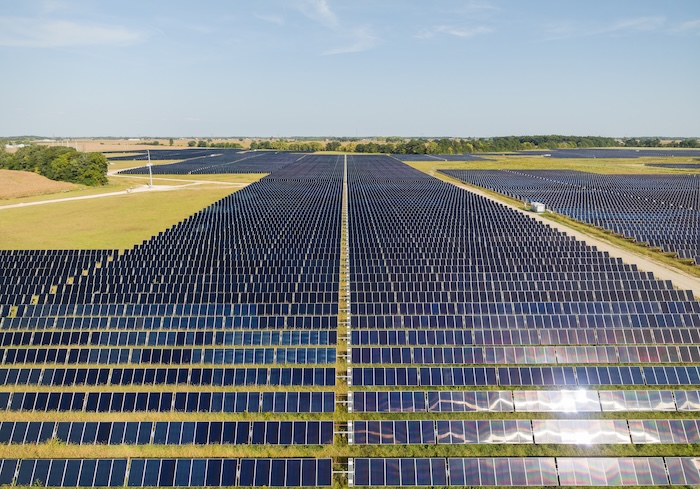Innovation is Creating New Opportunities in Utility Solar
The National Renewable Energy Laboratory predicts that utility-scale PV deployment in the U.S. will continue to grow exponentially over the next few decades: approximately 192 percent between 2024 and 2035 (from 148 gigawatts [GW] to 432 GW), and 113 percent between 2035 and 2050. This impressive growth is fueling innovation in solar inverter and module technology.

The pivotal role of solar inverters
The primary function of solar inverters is to convert the direct current (DC) generated by solar panels, which are also called PV modules, into alternating current (AC). AC energy is the form of electricity that is used to power homes and businesses.
However, solar inverters perform a variety of other important functions. They enhance the cost efficiency, reliability, and scalability of PV energy systems in a number of ways.
Inverter functions include:
- Performance Monitoring — Delivering valuable insights into how a PV system is performing, including real time data on energy production, alerts on any required maintenance, and updates on the system’s overall health.
- Protection and Safety — Offering rapid shutdown to protect against electrical fires, ground fault protection to prevent electric shocks, and anti-islanding projection to shut down the inverter in the event of grid power loss. Minimizing energy loss is very important since even 1 percent reduction can translate into millions of dollars.
- Maximum Output — Tracking the current and voltage of the solar modules to ensure that they are generating the highest amount of power possible. They accommodate for changes in temperature and the intensity of the sunlight.
- Energy curtailing/limiting loss — Synchronizing the AC output with the grid’s power in PV systems that are tied to the grid, so any excess energy can be fed back into it.
- Autonomous Optimization — Optimizing energy production and consumption; more advance inverters intelligently manage the flow between solar modules, the grid, battery storage system, and the building utilizing the power.
Solar inverters for a range of PV systems
The type of inverter utilized is normally left up to the developer, and often depends on several factors, including the type, size, and scale of the solar installation, and whether the PV system is on or off the grid.
String inverters are commonly found in residential, industrial, and an increasing number of utility-scale installations. They are so named because of their configuration. Multiple solar modules are connected in a series to form a string that is connected to a single inverter, which converts the power produced by the entire string to AC. String inverters are distributed throughout a PV system. Although they require higher initial upfront costs to implement, they are easily replaced with minimal impact to energy production.
Microinverters are smaller size inverters that are installed individually on a solar module to maximize its input. This type of inverter is particularly beneficial in installations where solar panels are shaded or configured in varying angles.
Central inverters convert DC to AC power on a much larger scale than string or microinverters. They are found in large-scale commercial and utility-scale solar panels due to their attractive price.
Hybrid inverters are designed to work in conjunction with BESS. Hybrid inverters not only convert DC to AC, but also charge and draw power from batteries.
Innovation delivers new module efficiencies
Today’s solar modules produce much more power per square foot than they did even five years ago.
- Improving on the original monofacial module, the new bifacial module has the ability to capture ambient light. Sun is captured on the face of the panel, and the ambient light is picked up from the back.
- Crystalline silicon modules now deliver higher efficiency; they offer an excellent option when space is at a premium.
- Thin-film solar modules, produced by depositing one or more thin layers of photovoltaic material onto a substrate (such as glass, plastic, or metal) are much thinner than conventional crystalline silicon panels, and are being adapted to work with string inverters.

A new era in megawatt-scale PV
Solar module and inverter technology is improving so quickly, it’s changing the game when it comes to utility-scale PV installations. Clients are looking to replace existing modules and inverters with more efficient technology that offers better energy capture, protection, and safety. Energy storage is being added that stores curtailed energy when the solar energy exceeds grid demand.
New solar inverter innovations, with their modular design and higher input voltages, are increasing efficiency and lowering costs. Real-time monitoring capabilities allow them to deliver greater uptime, reliability, and energy harvest — benefits that wouldn’t have been achievable with previous technology. As a result, the industry is now seeing efficiency ratings of greater than 99 percent.
Another important advance is IoT- and cloud-integration, which allows real-time data analytics to improve system monitoring and maintenance. This helps to extend the inverter’s lifespan and ensures consistent energy production.
With so much technology innovation occurring in the industry right now, it’s not surprising that the prospects for solar energy remain bullish in 2025. Continuous improvements in solar modules, inverters, and battery storage technology make solar power more cost-effective and reliable than ever. Photovoltaics remains one of the most affordable and cleanest sources of energy.
Greg Mazur, P.E., is Director of Engineering at Blymyer Engineers, which provides electrical, mechanical, structural, and civil engineering for renewable energy projects.
Blymyer Engineers | blymyer.com
Author: Greg Mazur, P.E.
Volume: 2025 March/April









.png?r=1027)



.jpg?r=6958)